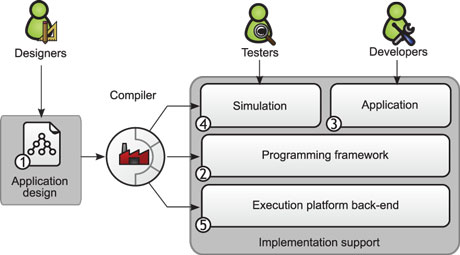by Charles Consel and Milan Kabac
The Internet of Things (IoT) has become a reality with the emergence of Smart Cities, populated with large amounts of smart objects which are used to deliver a range of citizen services (e.g., security, well being, etc.) The IoT paradigm relies on the pervasive presence of smart objects or “things”, which raises a number of new challenges in the software engineering domain.
The Object’s World project
There are an abundance of research and industry initiatives that have been undertaken with the aim of promoting the emergence of IoT [1]. In line with this goal, the Object’s World project brings together stakeholders from different domains to build and support the emergence of an IoT sector in France and beyond. The project is lead by SIGFOX, the world's first cellular network operator dedicated to low-bandwidth wireless objects. The cooperation between industry and research partners (e.g., sensor manufacturers, computer science and electrical engineering research labs) is of uttermost importance in overcoming technological barriers. This issue is currently hindering the development of an IoT sector. The main objectives of this project are the development of:
- expertise in the low-bandwidth network sector,
- low-cost transmitter/receiver chips,
- low-energy autonomous sensors, and
- software frameworks which cover the entire lifecycle of IoT applications.
Network infrastructures which support huge numbers of objects open up a range of opportunities for innovative services. Critically, these new opportunities rely on the ability to address the software engineering challenges of this new sector. We promote an approach that revolves around software frameworks. In areas such as mobile and web development, this approach has already been shown to facilitate software development by abstracting over implementation details and guiding the programmer.
A design-driven development approach
To guide and support the development of applications which orchestrate networked objects, our research group introduced a design-driven software development approach which draws on principles and techniques taken from the programming language domain.

In particular, we developed DiaSuite [2], a tool-based methodology which guides the developer through the entire lifecycle of an orchestrating application (Figure 1). DiaSuite offers a design language, providing high-level, declarative constructs that are dedicated to describing the application’s architecture, along with the smart objects it orchestrates. The methodology relies on a compiler that generates support in the form of a Java programming framework, customized with respect to a given application design. By providing the developer with a programming framework, our approach ensures conformity between the design and implementation. The generated programming framework provides the developer with an abstract class per component declaration. The application logic is implemented by sub-classing each abstract class and programming its abstract methods. To further ease the development of orchestrating applications, DiaSuite relies on Eclipse to guide developers during the implementation phase by introducing placeholders that need to be provided with code. Finally, our approach provides developers with a back-end to address the deployment and execution of orchestrating applications.
Orchestrating smart objects at a large scale
The development of orchestrating applications which are responsible for large numbers of smart objects raises a number of challenges. We have addressed these by introducing a new design language.
Service discovery
Standard service discovery at the individual object level does not address the needs of applications orchestrating large numbers of smart objects. Instead, a high-level approach which provides constructs to specifying sub-sets of interest is needed. Our approach allows developers to introduce application-specific concepts (e.g., regrouping parking spaces into lots or districts) at the design time and then these can be used to express discovery operations. Following our design-driven development approach, these concepts are used to generate code to support and guide the programming phase.
Data gathering
Applications need to acquire data from a large number of objects through a variety of delivery models. For instance, air pollution sensors across a city may only push data to the relevant applications when pollution levels exceed tolerated levels. Tracking sensors, however, might determine the location of vehicles and send the acquired measurements to applications periodically (e.g., 10 min. intervals). Data delivery models need to be introduced at design time since they have a direct impact on the application’s program structure. In doing so, the delivery models used by an application can be checked against sensor features early in the development process.
Data processing
Data that is generated from hundreds of thousands of objects and accumulated over a period of time calls for efficient processing strategies to ensure the required performance is attained. Our approach allows for an efficient implementation of the data processing stage by providing the developer with a framework based on the MapReduce [3] programming model which is intended for the processing of large data sets.
Future work
We envisage to enrich our design-driven methodology with support for simulation of infrastructures of smart objects. To achieve this, we will leverage design-time declarations to generate application-specific simulation support, while keeping the application code unchanged.
Links:
http://www.sigfox.com/en/
http://www.telecom-design.com/en/
http://phoenix.inria.fr/
References:
[1] D. Miorandi et al.: “Internet of things: Vision, applications and research challenges,” Ad Hoc Networks, vol. 10, no. 7, 2012
[2] D. Cassou, et al., “Towards A Tool-Based Development Methodology for Pervasive Computing Applications,” IEEE Transactions on Software Engineering, 2011
[3] J. Dean and S. Ghemawat, “MapReduce: simplified data processing on large clusters,” Communications of the ACM, 2008
Please contact:
Charles Consel
University of Bordeaux / Inria Bordeaux - Sud-Ouest,
E-mail:
Milan Kabac
Inria Bordeaux - Sud-Ouest,
E-mail:











